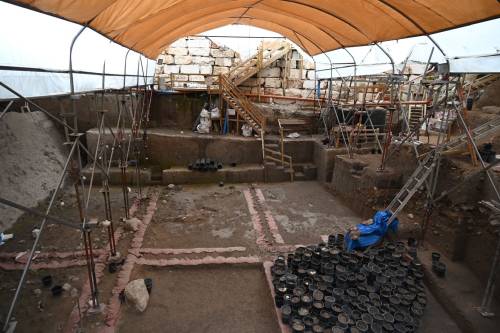A Second-Temple-period inn that served travelers moving between Tiberias and Sepphoris is being excavated near the Golani Junction. Volunteers are welcome now through March.
“Archaeologists have uncovered an ancient glass workshop in the Jewish quarter of Hebron, dating back to the 13th and 14th centuries.”
The Jerusalem Post has more information about the new archaeological exhibit at Ben Gurion airport, as does The Times of Israel. The Rabbi of the Western Wall wants his stone back.
“The Israel Antiquities Authority (IAA) has rejected the idea of receiving responsibility for antiquities in the West Bank.”
Ran Silberman reviews the history and interpretation of the “Pool of Siloam” over the last twenty years.
Adam Montefiore explains the significance of Tu BeShvat, the Israeli festival for planting trees.
The list of sessions for this week’s Archaeology and Site Conservation of Judea and Samaria international conference is online. The PEF and others denounced the event. An academic boycott of archaeological research in these areas is hurting researchers.
Nathan Steinmeyer gives a brief introduction to the importance of the Judean Desert in biblical history.
Andrew Lawler writes for Archaeology Magazine about the origin of the pork taboo.
The Jerusalem Post interviewed Doron Spielman about his forthcoming book, When the Stones Speak: The Remarkable Discovery of the City of David and What Israel’s Enemies Don’t Want You To Know.
The T&T Clark Encyclopedia of Second Temple Judaism is much cheaper in paperback (vol. 1, vol. 2) than it is in hardcover.
Brad Gray explores the good shepherd in the latest episode of the “Biblical Images of God” series at Walking The Text.
Michael Hasel and Yosef Garfinkel discuss the ivory comb of Lachish on the latest episode of The Book and the Spade.
Yesterday’s “Jerusalem in Brief” looks at the Ordnance Survey Map of 1865, Kathleen Kenyon’s view of ancient Jerusalem, and a new book by Lukas Landmann with high-quality photos.
The University of Haifa’s School of Archaeology and Maritime Cultures has begun an English-taught Master’s program on Heritage Management.
Online lecture on March 1: “Teaching Scripture in the Context of the Biblical World,” with Oliver Hersey and Jack Beck. The announcement also notes that Jerusalem University College will offer a $500 discount on a short-term course to those who register.
HT: Agade, Gordon Franz, Arne Halbakken, Explorator, Paleojudaica
